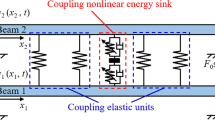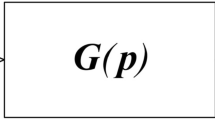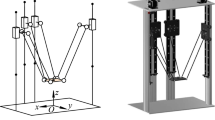Abstract
In this paper, the new form of Kane’s equations of motion for constrained systems is derived based on the general dynamic equation in the form of virtual power. A new dynamic modeling method for large rotation and deformation analysis of a flexible multibody system that undergoes arbitrary displacements is proposed based on the new form of Kane’s equations and the absolute nodal coordinate formulation. The equations of motion of the flexible multibody system established by the proposed modeling method are a set of pure differential equations without multipliers, and they have a unified compact form, which helps to design the controller and can avoid the inconvenience caused by the undetermined multipliers in the numerical calculations. Finally, a planar flexible double pendulum system is modeled by using the proposed modeling method and the Lagrange method of the first kind, respectively, and the validity and feasibility of the proposed method are demonstrated by comparing the numerical results obtained from the above two methods.





Similar content being viewed by others
References
Hooker, W.W., Margulies, G.: The dynamical attitude equations for an N-body satellite. J. Astronaut. Sci. 12(4), 123–128 (1965)
Wang, J.T., Huston, R.L.: Kane’s equations with undetermined multipliers—application to constrained multibody systems. J. Appl. Mech. 54(2), 424–429 (1987). doi:10.1115/1.3173031
Kamman, J.W., Huston, R.L.: Dynamics of constrained multibody systems. J. Appl. Mech. 51(4), 899–903 (1984). doi:10.1115/1.3167743
Xu, H., Ma, X., Huang, W., Shao, C., Zou, Z.: The dynamical problems investigation on dual-robot system with coordinated constraints. J. Vib. Eng. 7(1), 1–8 (1994) (in Chinese)
Singh, R.P., Likins, P.W.: Singular value decomposition for constrained dynamical systems. J. Appl. Mech. 52(4), 943–948 (1985). doi:10.1115/1.3169173
Udwadia, F.E.: Equations of motion for mechanical systems: a unified approach. Int. J. Non-Linear Mech. 31(6), 951–958 (1996). doi:10.1016/S0020-7462(96)00116-3
Bajodah, A.H., Hodges, D.H., Chen, Y.H.: New form of Kane’s equations of motion for constrained systems. J. Guid. Control Dyn. 26(1), 79–88 (2003). doi:10.2514/2.5017
Hu, Q., Jia, Y., Xu, S.: An improved Kane’s method for multibody dynamics. Chin. J. Theor. Appl. Mech. 43(5), 968–972 (2011) (in Chinese)
Meirovitch, L.: A new method of solution of the eigenvalue problem for gyroscopic systems. AIAA J. 12(10), 1337–1342 (1974). doi:10.2514/3.49486
Singh, R.P., Vandervoort, R.J., Likins, P.W.: Dynamics of flexible bodies in tree topology—a computer-oriented approach. J. Guid. Control Dyn. 8(5), 584–590 (1985). doi:10.2514/3.20026
Ho, J.Y.L.: Direct path method for flexible multibody spacecraft dynamics. J. Spacecr. Rockets 14(2), 102–110 (1977). doi:10.2514/3.57167
Likins, P.: Spacecraft attitude dynamics and control—a personal perspective on early developments. J. Guid. Control Dyn. 9(2), 129–134 (1986). doi:10.2514/3.20080
Shabana, A.A.: An absolute nodal coordinates formulation for the large rotation and deformation analysis of flexible bodies. Technical report No. MBS96-1-UIC, University of Illinois at Chicago (1996)
Berzeri, M., Campanelli, M., Shabana, A.: Definition of the elastic forces in the finite-element absolute nodal coordinate formulation and the floating frame of reference formulation. Multibody Syst. Dyn. 5(1), 21–54 (2001). doi:10.1023/A:1026465001946
García-Vallejo, D., Sugiyama, H., Shabana, A.A.: Finite element analysis of the geometric stiffening effect. Part 1: a correction in the floating frame of reference formulation. Proc. Inst. Mech. Eng., Proc., Part K, J. Multi-Body Dyn. 219(2), 187–202 (2005). doi:10.1243/146441905x10041
García-Vallejo, D., Sugiyama, H., Shabana, A.A.: Finite element analysis of the geometric stiffening effect. Part 2: non-linear elasticity. Proc. Inst. Mech. Eng., Proc., Part K, J. Multi-Body Dyn. 219(2), 203–211 (2005). doi:10.1243/146441905x10050
Li, B., Liu, J.: Application of absolute nodal coordination formulation in flexible beams with large deformation. J. Shanghai Jiaotong Univ. 39(5), 827–831 (2005) (in Chinese)
Shabana, A.A., Christensen, A.P.: Three-dimensional absolute nodal co-ordinate formulation: plate problem. Int. J. Numer. Methods Eng. 40(15), 2775–2790 (1997). doi:10.1002/(SICI)1097-0207(19970815)40:15<2775::AID-NME189>3.0.CO;2-%23
Mikkola, A.M., Shabana, A.A.: A non-incremental finite element procedure for the analysis of large deformation of plates and shells in mechanical system applications. Multibody Syst. Dyn. 9(3), 283–309 (2003). doi:10.1023/A%3A1022950912782
Dufva, K., Shabana, A.A.: Analysis of thin plate structures using the absolute nodal coordinate formulation. Proc. Inst. Mech. Eng., Proc., Part K, J. Multi-Body Dyn. 219(4), 345–355 (2005). doi:10.1243/146441905x50678
García-Vallejo, D., Mayo, J., Escalona, J.L., Domínguez, J.: Efficient evaluation of the elastic forces and the Jacobian in the absolute nodal coordinate formulation. Nonlinear Dyn. 35(4), 313–329 (2004). doi:10.1023/B:NODY.0000027747.41604.20
Shabana, A.A.: Dynamics of Multibody Systems, 3rd edn. Cambridge University Press, New York (2005)
Omar, M.A., Shabana, A.A.: A two-dimensional shear deformable beam for large rotation and deformation problems. J. Sound Vib. 243(3), 565–576 (2001). doi:10.1016/j.jsv.2003.12.044
Kerkkänen, K.S., Sopanen, J.T., Mikkola, A.M.: A linear beam finite element based on the absolute nodal coordinate formulation. J. Mech. Des. 127(4), 621–630 (2004). doi:10.1115/1.1897406
Dufva, K.E., Sopanen, J.T., Mikkola, A.M.: A two-dimensional shear deformable beam element based on the absolute nodal coordinate formulation. J. Sound Vib. 280(3–5), 719–738 (2005). doi:10.1016/j.jsv.2003.12.044
García-Vallejo, D., Mikkola, A.M., Escalona, J.L.: A new locking-free shear deformable finite element based on absolute nodal coordinates. Nonlinear Dyn. 50(1–2), 249–264 (2007). doi:10.1007/s11071-006-9155-4
Shabana, A.A., Yakoub, R.Y.: Three dimensional absolute nodal coordinate formulation for beam elements: theory. J. Mech. Des. 123(4), 606–613 (2000). doi:10.1115/1.1410100
Yakoub, R.Y., Shabana, A.A.: Three dimensional absolute nodal coordinate formulation for beam elements: implementation and applications. J. Mech. Des. 123(4), 614–621 (2000). doi:10.1115/1.1410099
Dufva, K., Sopanen, J.T., Mikkola, A.M.: Three-dimensional beam element based on a cross-sectional coordinate system approach. Nonlinear Dyn. 43(4), 311–327 (2006). doi:10.1007/s11071-006-8326-7
Gerstmayr, J., Matikainen, M.K.: Analysis of stress and strain in the absolute nodal coordinate formulation. Mech. Based Des. Struct. Mach. 34(4), 409–430 (2006). doi:10.1080/15397730601044895
Dufva, K., Shabana, A.A.: Analysis of thin plate structures using the absolute nodal coordinate formulation. Proc. Inst. Mech. Eng., Proc., Part K, J. Multi-Body Dyn. 219(4), 345–355 (2005). doi:10.1243/146441905X50678
Kübler, L., Eberhard, P., Geisler, J.: Flexible multibody systems with large deformations using absolute nodal coordinates for isoparametric solid brick elements. In: ASME 2003 International Design Engineering Technical Conferences and Computers and Information in Engineering Conference, Chicago, Illinois, DETC2003/VIB-48303 (2003). doi:10.1115/DETC2003/VIB-48303
Tian, Q., Chen, L.P., Zhang, Y.Q., Yang, J.: An efficient hybrid method for multibody dynamics simulation based on absolute nodal coordinate formulation. J. Comput. Nonlinear Dyn. 4(2), 021009 (2009). doi:10.1115/1.3079783
Acknowledgements
This work is supported by Doctoral Fund of Ministry of Education of China (Grant No. 20112302120005). The support is gratefully acknowledged.
Author information
Authors and Affiliations
Corresponding author
Rights and permissions
About this article
Cite this article
Zhao, J., Zhao, R., Xue, Z. et al. A new modeling method for flexible multibody systems. Multibody Syst Dyn 35, 179–190 (2015). https://doi.org/10.1007/s11044-014-9423-x
Received:
Accepted:
Published:
Issue Date:
DOI: https://doi.org/10.1007/s11044-014-9423-x




